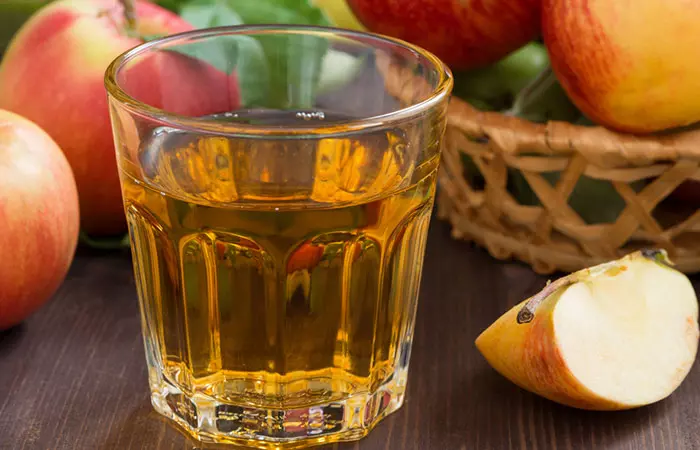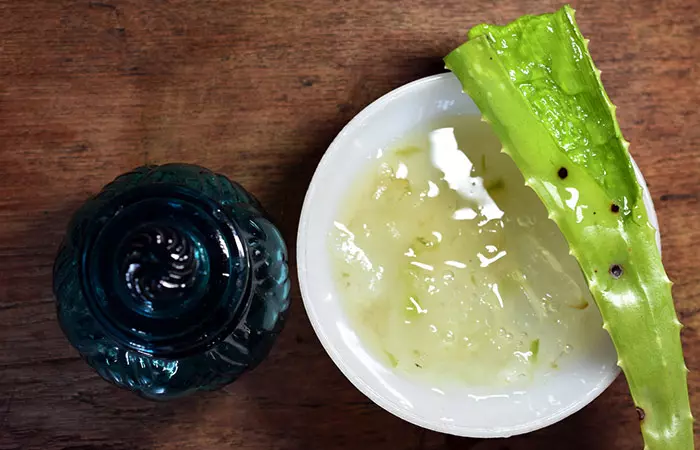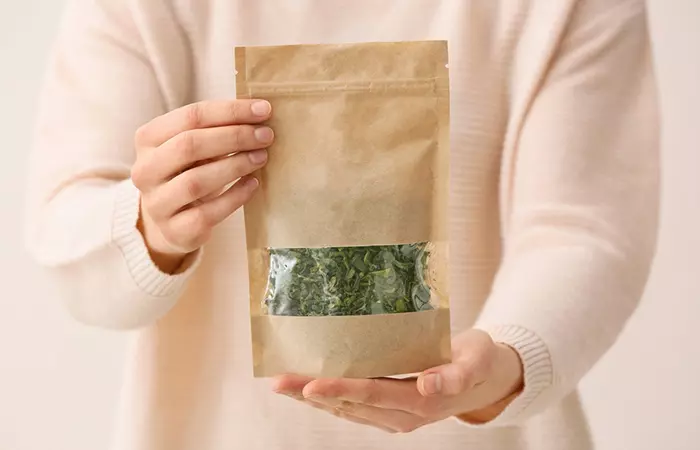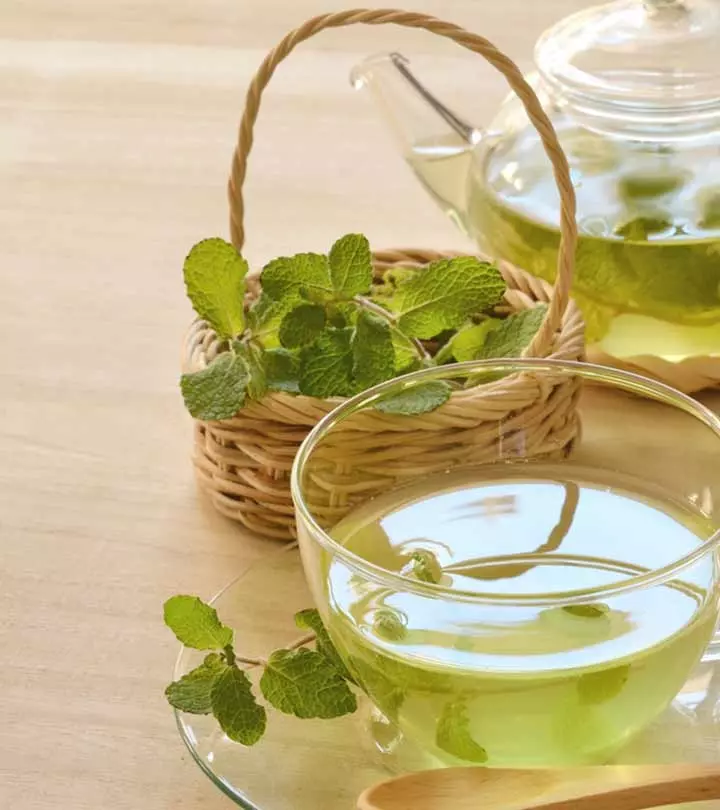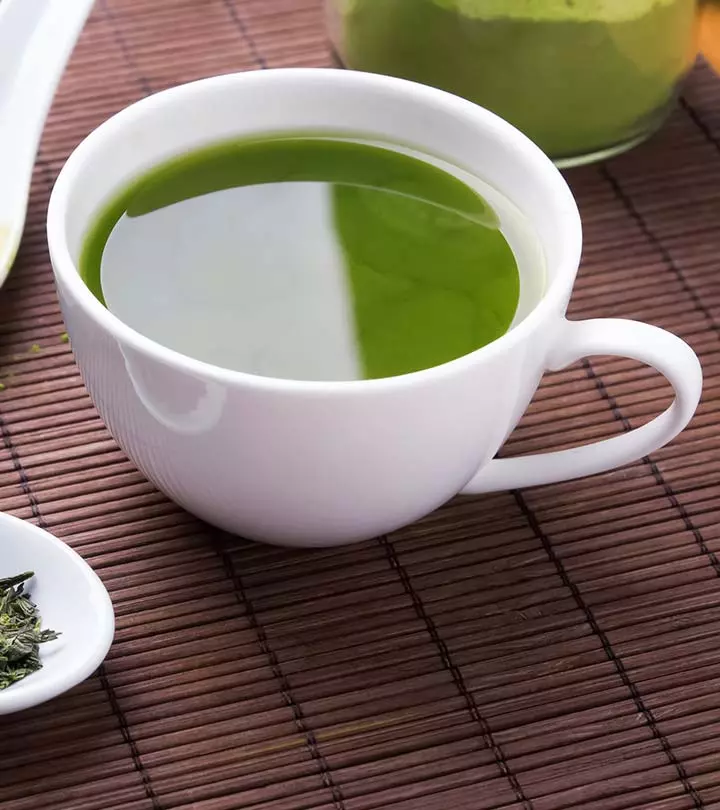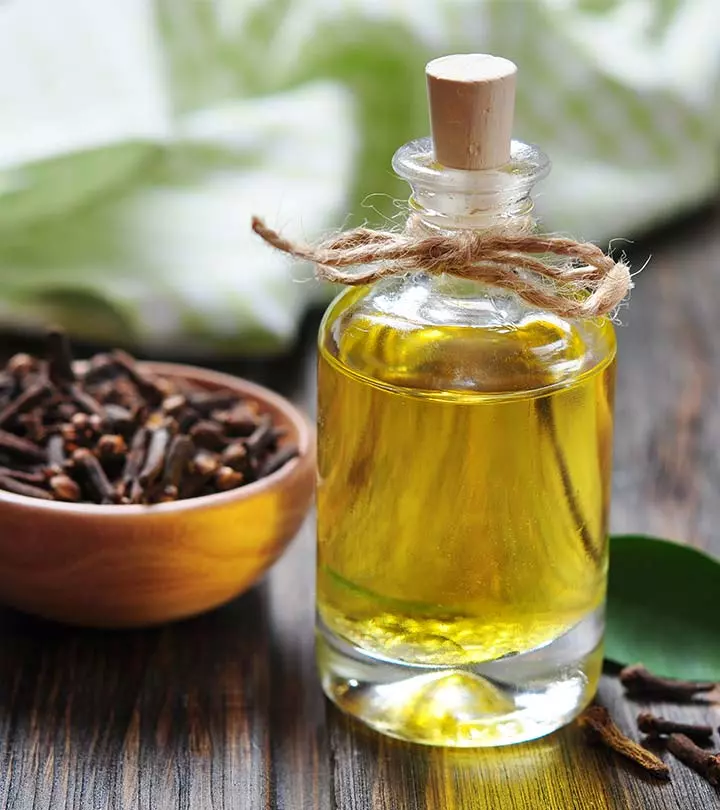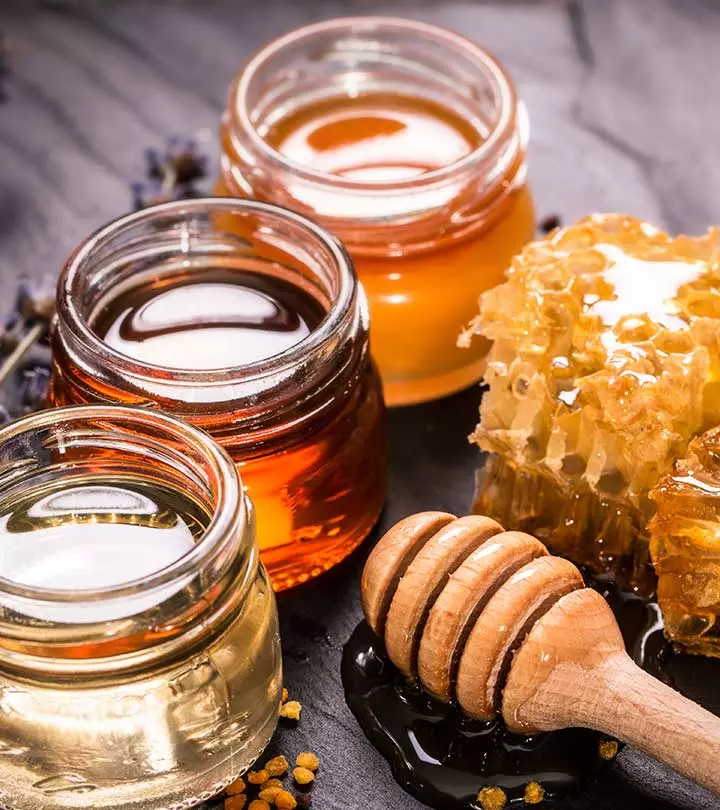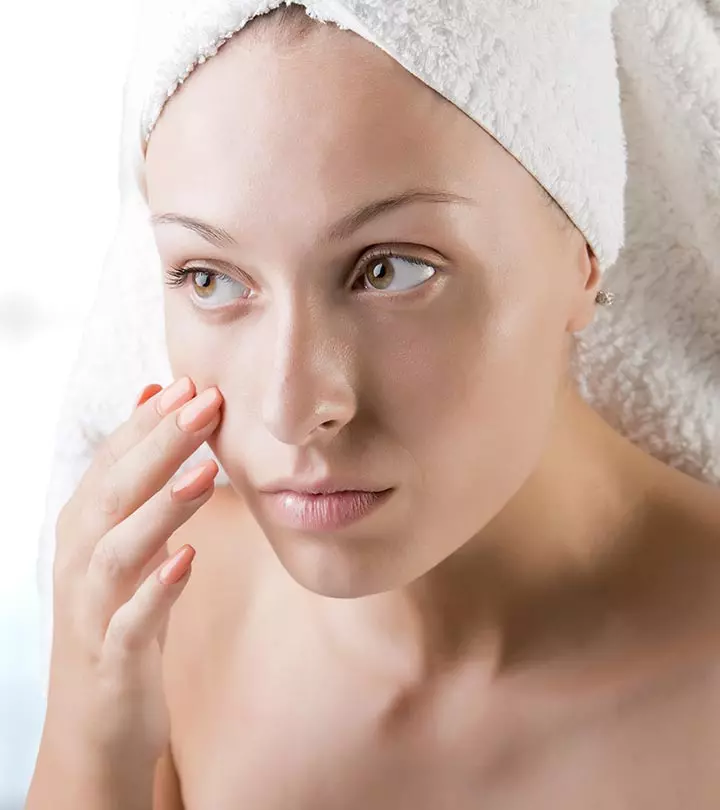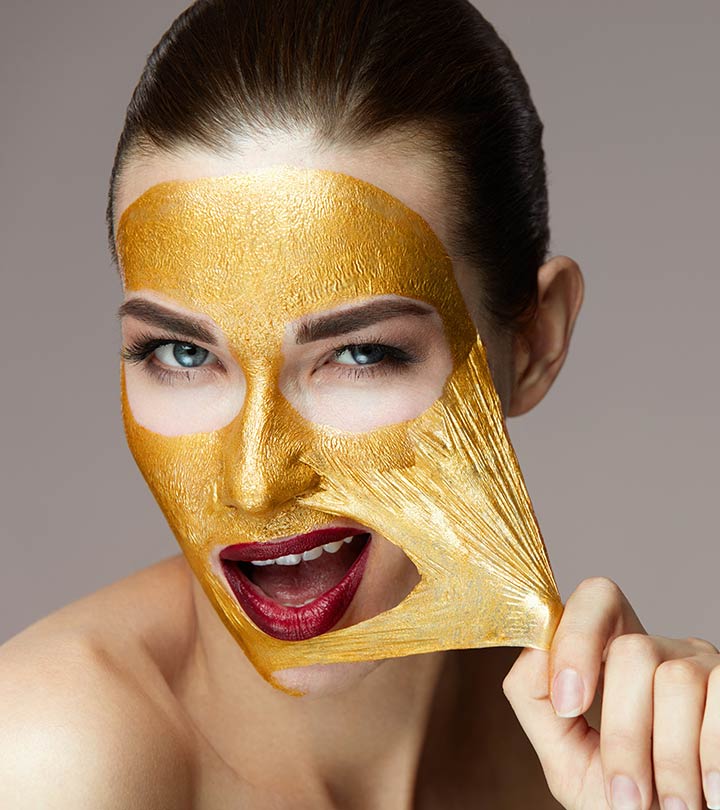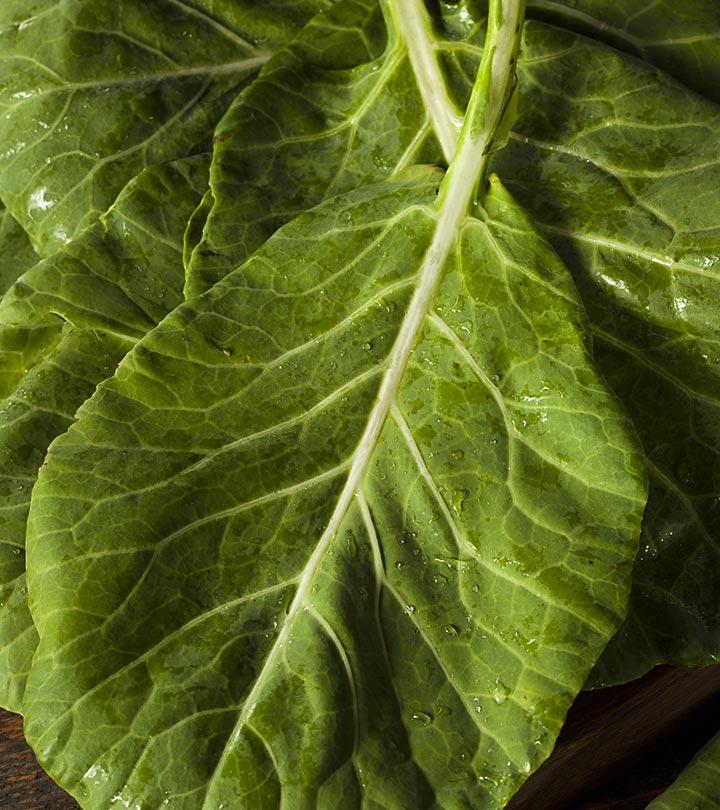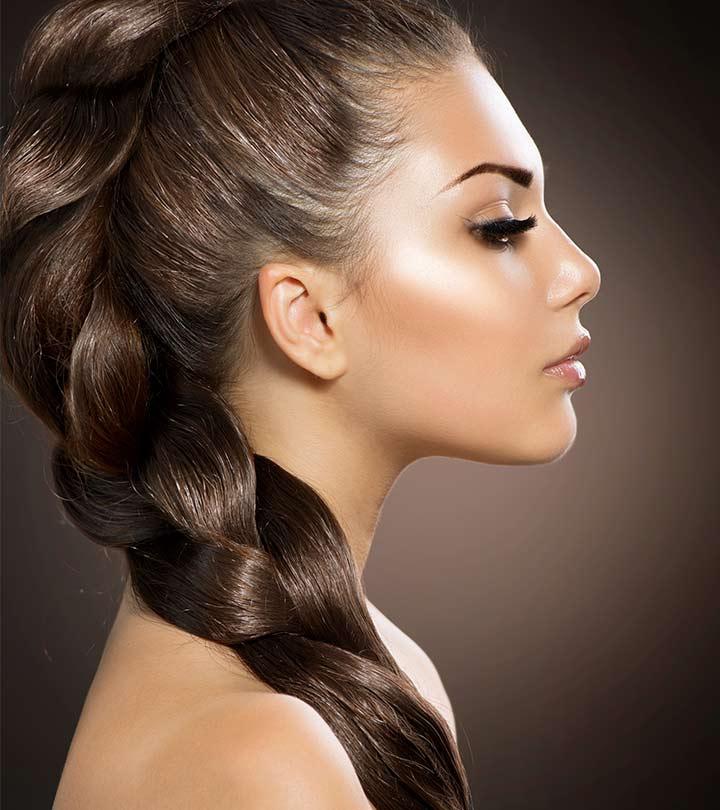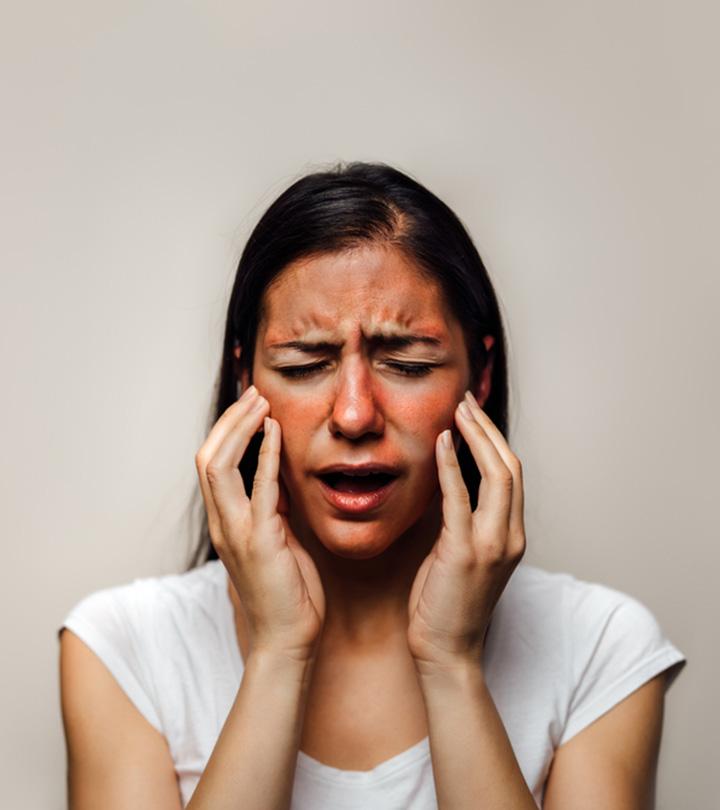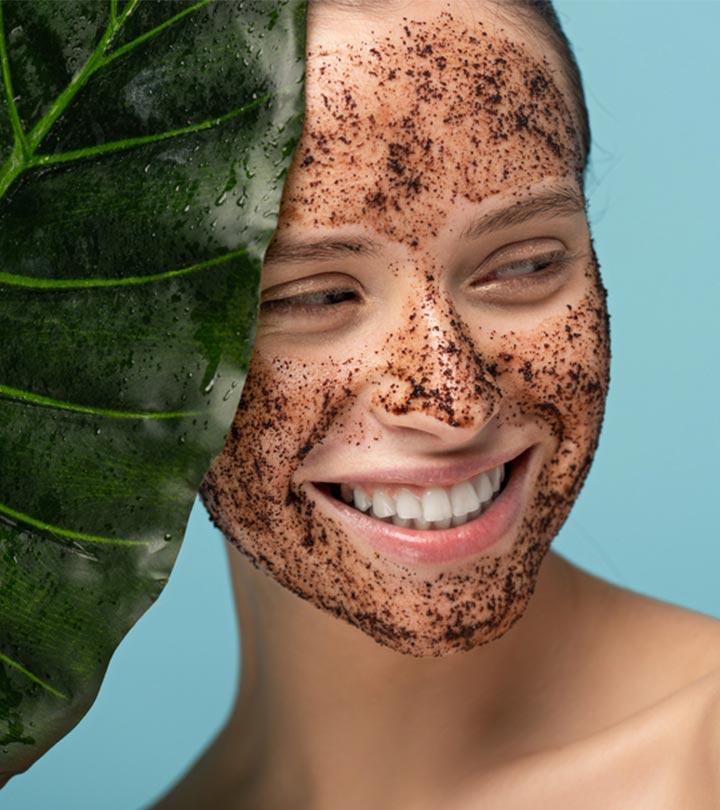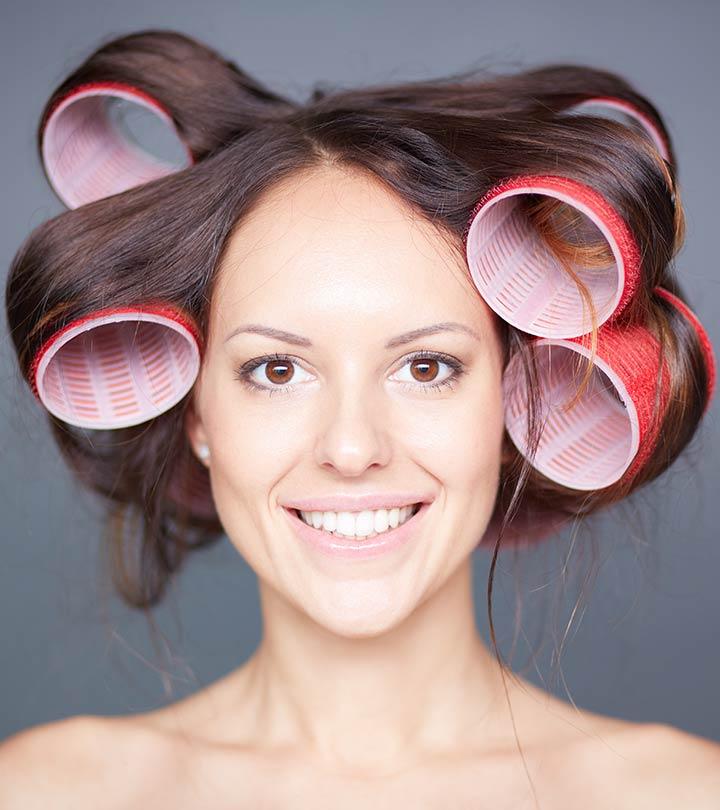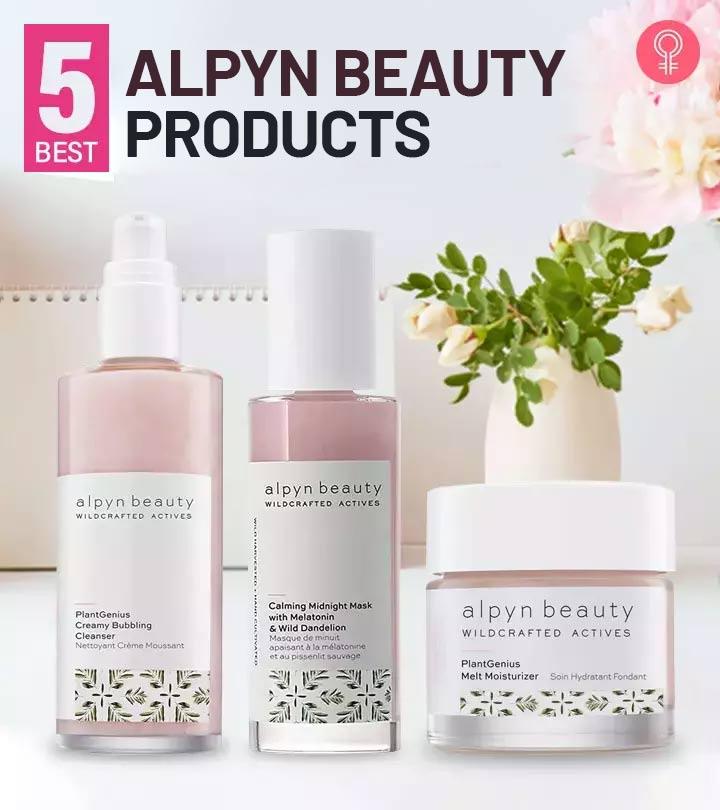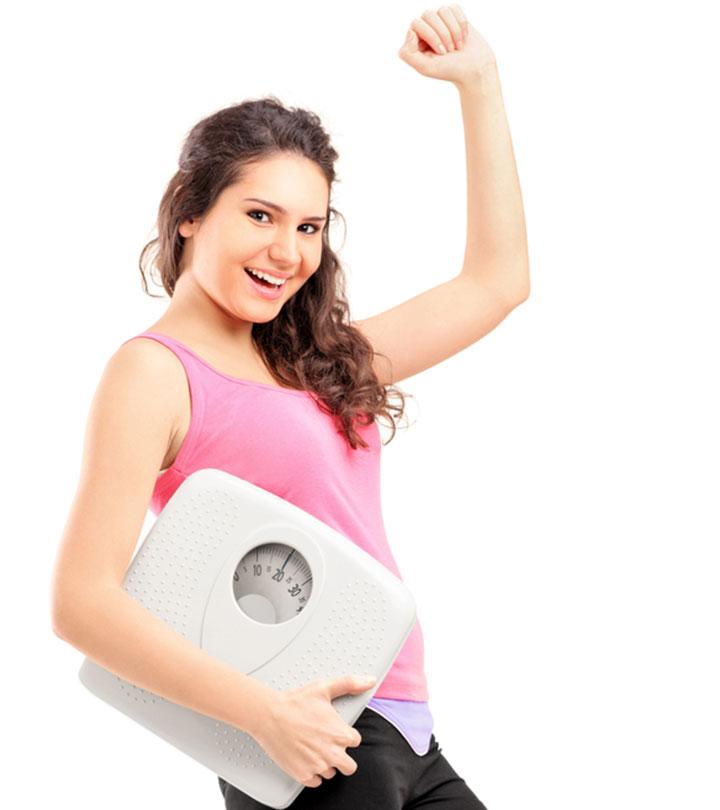Can Green Tea Help Treat Acne? How To Use It
Take advantage of this antioxidant-rich tea the right way for clean and clear skin.

Image: ShutterStock
Green tea is excellent for maintaining your overall health. It is also used in skin care products for its skin-soothing benefits. However, there have been claims that using green tea for acne can help ease the symptoms. Is there any truth to the claim?
Green tea is rich in polyphenols, a type of potent antioxidant. According to a study, topical tea polyphenols may soothe and heal mild to moderate acne (1). Moreover, there are other beneficial compounds in green tea, which may help reduce inflammation and soothe acne-prone skin. It is also safe for sensitive skin and does not irritate skin. It is also a common ingredient in many skin detoxification products.
While you can consume green tea, you can also use it topically to soothe mild to moderate acne. Scroll down to learn the ways green tea may work for your acne and DIY remedies you may try.
In This Article
Does Green Tea Help Acne? What Are The Benefits?
Yes, green tea may help you deal with acne vulgaris because of the following benefits:
1. It Helps Reduce Inflammation
Green tea is rich in catechins. Out of the four major catechins identified in green tea, epigallocatechin-3-gallate (EGCG) has been found to be beneficial in treating acne and rosacea. It works by reducing inflammation. In a study, the application of 2% green tea lotion was found to reduce inflammatory acne (1).
EGCG is a powerful antioxidant and has immunomodulatory and photoprotective properties. It also has antiangiogenic (meaning, it reduces the growth of new blood vessels needed by the tumors for growth) and anti-inflammatory effects (2).
 Quick Tip
Quick Tip2. It Helps Reduce Sebum Production
Excess production of sebumi The natural oils produced by sebaceous glands that keep your skin hydrated. is one of the main causes of acne. The topical application of green tea can help in reducing sebum secretion and treating acne.
A study involving 22 non-smoking, healthy men examined the effect of a 5% topical green tea extract for 60 days. The researchers found a significant reduction in sebum secretion (1).
Drinking green tea may also help in reducing sebum production and control acne.
 Did You Know?
Did You Know?3. The Polyphenols In Green Tea Help Reduce Acne
Green tea polyphenols are potent antioxidants. A clinical trial examined the effect of 2% tea lotion on 47 subjects with mild to moderate acne. After two weeks, the researchers observed a therapeutic effect on acne lesions (1).
 Trivia
Trivia4. It Helps Reduce Acne-causing Bacteria
An 8-week study found that EGCG, one of the four major catechins in green tea, could help reduce acne by inhibiting the growth of P. acnes bacteria (3).
Aside from these properties that help reduce acne, it also has other advantages for your skin, such as sun protection. The antioxidants present in green tea, such as catechins, can help safeguard your skin from harmful UV rays (4). When applied topically, green tea extracts can act as a protective shield against sunburn and skin damage (5). In addition, consuming green tea regularly may enhance the skin’s ability to defend itself against UV radiation from within (6).
However, it is important to note that while green tea can complement your sunscreen regimen, it should not replace it entirely. For optimal sun protection, combine it with a broad-spectrum sunscreen, protective clothing, and adequate use of shade.
These studies are not conclusive, and further research is needed to evaluate the effectiveness and benefits of green tea on acne. Also, note that green tea or any other home remedy may not work for cystic and hormonal acne. You need to consult a doctor for proper treatment.
However, if you have mild to moderate acne, you may try using (or consuming) green tea at home to manage your condition. Here are a few recipes that you may try at home.
How To Use Green Tea For Acne: Easy Home Remedies
1. Honey And Green Tea For Acne
Honey has antimicrobiali Preventing the spread of microorganisms like viruses, bacteria, and fungi that cause infections and diseases. and wound-healing properties. It can inhibit the growth of P. acnes bacteria and help reduce acne (7).
You Will Need
- 1 green tea bag
- 1 tablespoon organic honey
- Hot water
- Facial cleanser
- Towel
Method
- Steep a green tea bag in hot water for about 3 minutes.
- Remove the bag and let it cool. Cut open the bag and extract the leaves.
- Add the honey to the leaves.
- Wash your face with a facial cleanser and pat it dry.
- Apply the honey and green tea mixture to your face and leave it on for about 20 minutes.
- Rinse with cool water and pat dry.
How Often?
- 3-4 times a week.
2. Green Tea Face Mist For Acne
This facial mist will help soothe your skin. It helps minimize skin redness and treats existing acne. It also boosts skin rejuvenation and skin brightening. The EGCG in green tea helps manage acne. This pimple treatment can be more effective if you also consume green tea regularly.
You Will Need
- Facial cleanser
- Green tea
- Spray bottle
- Non-comedogenici A product or ingredient that does not clog skin pores. moisturizer
- Towel
Method
- Brew some green tea and let it cool completely. (You can drink most of it and spare 2-3 tablespoons for this treatment.)
- Pour the cooled green tea into a spray bottle.
- Wash your face with a facial cleanser and pat it dry with a towel.
- Spritz the green tea on your face and let it dry.
- Rinse with cold water and pat your skin dry with a towel.
- Apply moisturizer.
How Often?
- 2 times a day.
3. Apple Cider Vinegar And Green Tea For Acne
There is no study proving the acne-fighting abilities of ACV. However, ACV is a popular home remedy for various skin issues. It is thought to help with skin toning and minimize skin pores. It may also balance the pH levels of your skin. You can use this concoction as a facial toner after skin cleansing. It is also a good and safe topical treatment for acne rosacea.
You Will Need
- ¼ cup apple cider vinegar
- ¾ cup brewed green tea
- Non-comedogenic moisturizer
- Facial cleanser
- Towel
- Cotton pad
- Glass jar
Method
- Brew some green tea and let it cool completely.
- Combine the cooled green tea and apple cider vinegar and pour it into a glass jar for storage. (Store the mixture in your fridge.)
- Wash your face with a facial cleanser and pat it dry with a towel.
- Saturate a cotton pad with the mixture and dab it on your face. Let it dry.
- Apply moisturizer.
How Often?
- 2 times a day.
4. Tea Tree Oil And Green Tea For Acne
Topical tea tree oil (5%) is known to be an effective treatment for mild to moderate acne (8). It has strong antimicrobial properties that are effective against acne.
You Will Need
- ½ cup green tea
- 3-4 drops tea tree essential oil
- Cotton pad
- Facial cleanser
- Non-comedogenic moisturizer
- Towel
Method
- Brew some green tea and let it cool completely.
- Combine the cooled green tea and tea tree oil and pour it into a glass jar for storage. (Store the mixture in your fridge.)
- Wash your face with a facial cleanser and pat it dry with a towel.
- Saturate a cotton pad with the mixture and dab it on your face. Let it dry. Shake well before using.
- Apply moisturizer.
How Often?
- 2 times a day.
Tiffany, a blogger, shared her experience of using a concoction of green tea and tea tree to manage her acne and improve her overall skin health. She said, “ I happen to love this recipe as the cleanser lathers nicely, takes off all of my makeup, and leaves my skin feeling soft and clean, without drying it out (i).”
5. Aloe Vera And Green Tea For Acne
Aloe vera has an anti-acne effect on the skin. The mucopolysaccharidesi Sugar molecule chains present throughout the body, especially in the mucus and fluids around the joints. present in it boost skin hydration by binding moisture to the skin and stimulating the fibroblastsi Cells that form connective tissues and produce collagen proteins that uphold the tissue connectivity framework. that produce collagen and elastin to keep your skin young and plump (9).
You Will Need
- 2 green tea bags
- 1 cup water
- 1 tablespoon fresh aloe vera gel
- Cotton pad
- Facial cleanser
- Non-comedogenic moisturizer
- Towel
Method
- Steep two bags of green tea in a cup of boiling water to get a strong solution. Allow the solution to cool.
- Combine the cooled green tea and aloe vera gel and pour it into a glass jar for storage. (Store the mixture in your fridge.)
- Wash your face with a facial cleanser and pat it dry with a towel.
- Saturate a cotton pad with the mixture and dab it onto your face. Let it dry.
- Apply your moisturizer.
How Often?
- 2 times a day.
6. Lemon And Green Tea For Acne
Lemon juice contains vitamin C and citric acid. It is part of many popular home remedies and is used for its astringent properties. It is said to tighten the skin pores and have mild bleaching properties. Together with green tea, lemon juice can help keep your skin free from acne. However, it can make your skin photosensitive, so apply sunscreen whenever you go out.
You Will Need
- ¼ cup green tea
- Juice of 1 lemon
- Cotton pad
- Facial cleanser
- Non-comedogenic moisturizer
- Towel
Method
- Brew a quarter cup of green tea and let it cool completely.
- Mix the cooled green tea with the juice of a lemon and pour it into a glass jar for storage. (Store the mixture in your fridge.)
- Wash your face with a facial cleanser and pat it dry with a towel.
- Saturate a cotton pad with the mixture and dab it onto your face. Let it dry.
- Apply moisturizer.
How Often?
- 2 times a day.
7. Olive Oil And Green Tea For Acne
Olive oil is one of the best options for oil cleansing. Oil cleansing helps to clean traces of makeup and dirt without upsetting the natural balance of your skin. Applying green tea brew on your face helps to calm it down and reduce skin inflammation.
You Will Need
- Facial cleanser
- Green tea
- Spray bottle
- 1 tablespoon extra virgin olive oil
- Towel
Method
- Brew some green tea and let it cool completely. (You can drink most of it and spare 2-3 tablespoons for this treatment.)
- Pour the cooled green tea into a spray bottle.
- Massage the olive oil on your face. Let it stay for a few minutes.
- Dip a washcloth in warm water, wring it, and wipe your face with the cloth.
- Wash your face with a facial cleanser and pat it dry with a towel.
- Spritz the green tea on your face and let it dry.
How Often?
- Every day.
Apart from the home remedies, there is another way to use green tea for acne. You can buy powdered or liquid green tea extract with EGCG, mix it with your favorite cream, and apply it to your skin. These extracts are easily available online.
Green Tea For Acne: Tips To Pick The Best Quality Green Tea
Picking the right green tea with the highest levels of antioxidants (especially EGCG) is tricky. The content of antioxidants varies from brand to brand. You need to be careful before you choose your brew. Whether it is for drinking or topical application, selecting the right green tea is essential to reap the maximum benefits. Here are some tips to keep in mind while picking your brew:
Do a bit of research. Check the label of the brand and see the amount of EGCG it has per serving. Browse their website and find out the EGCG levels. Choose the one with the highest EGCG content.
Loose leaves have a higher antioxidant content than tea bags. However, if you cannot find loose leaves, you may pick tea bags with the highest EGCG content.
Green tea has a shelf life of only 6 months. Make sure you are picking a fresh batch of green tea. As time passes, the freshness of green tea and its benefits diminish fast.
Look at the harvest time. The first harvest of green tea is always the best than the second one. The first harvest has the highest quality leaves, and they are picked during the early months of the year (between March and April). Always buy first harvest green tea.
Pick organic green tea. This ensures that the green tea is harvested without any pesticides and other chemicals.
Infographic: Top 4 Benefits Of Green Tea For Acne
Green tea has been around for ages and is loved by people worldwide. This ingredient is a jack of multiple trades and is used in skin care and home remedies. Green tea is a powerful anti-acne skin care ingredient for whiteheads and blackheads. It may help manage other skin woes too. It may be paired with different other ingredients for maximum benefits. Check out the infographic below to find out the top benefits of green tea for acne.

Illustration: StyleCraze Design Team
Green tea is good for your overall health and your skin. Green tea extract has antioxidants and anti-inflammatory properties that may help soothe mild to moderate acne. If you want to use green tea for acne, you can use products containing green tea extract or follow the DIY remedies suggested in the article. You may also consume green tea for healthy lifestyle and skin benefits. However, remember that home remedies may not work for hormonal or cystic acne. You must consult a doctor and follow the prescribed treatment.
Frequently Asked Questions
Which is the best green tea brand for acne?
Pick any organic brand and check the label for its antioxidant content. Usually, Japanese brands are considered the best. You will easily get them online.
What are the other best teas for acne?
All teas may not have the same effect on acne as green tea. However, drinking herbal teas may boost your antioxidant levels. You may try other teas, such as rooibos tea, chamomile tea, spearmint tea, dandelion tea, and ginger tea.
Can green tea clear dark spots?
Possibly. In fact, in a study, green tea had demonstrated therapeutic efficacy in the treatment of melasma (10).
Key Takeaways
- Green tea may help lessen inflammation and prevent acne as it has antioxidants, particularly EGCG.
- Green tea may prevent sebum production if applied topically.
- Honey and green tea mixture may prevent P.acnes bacteria as honey has antibacterial properties.
- You can also mix green tea with lemon and olive oil for effective treatment.
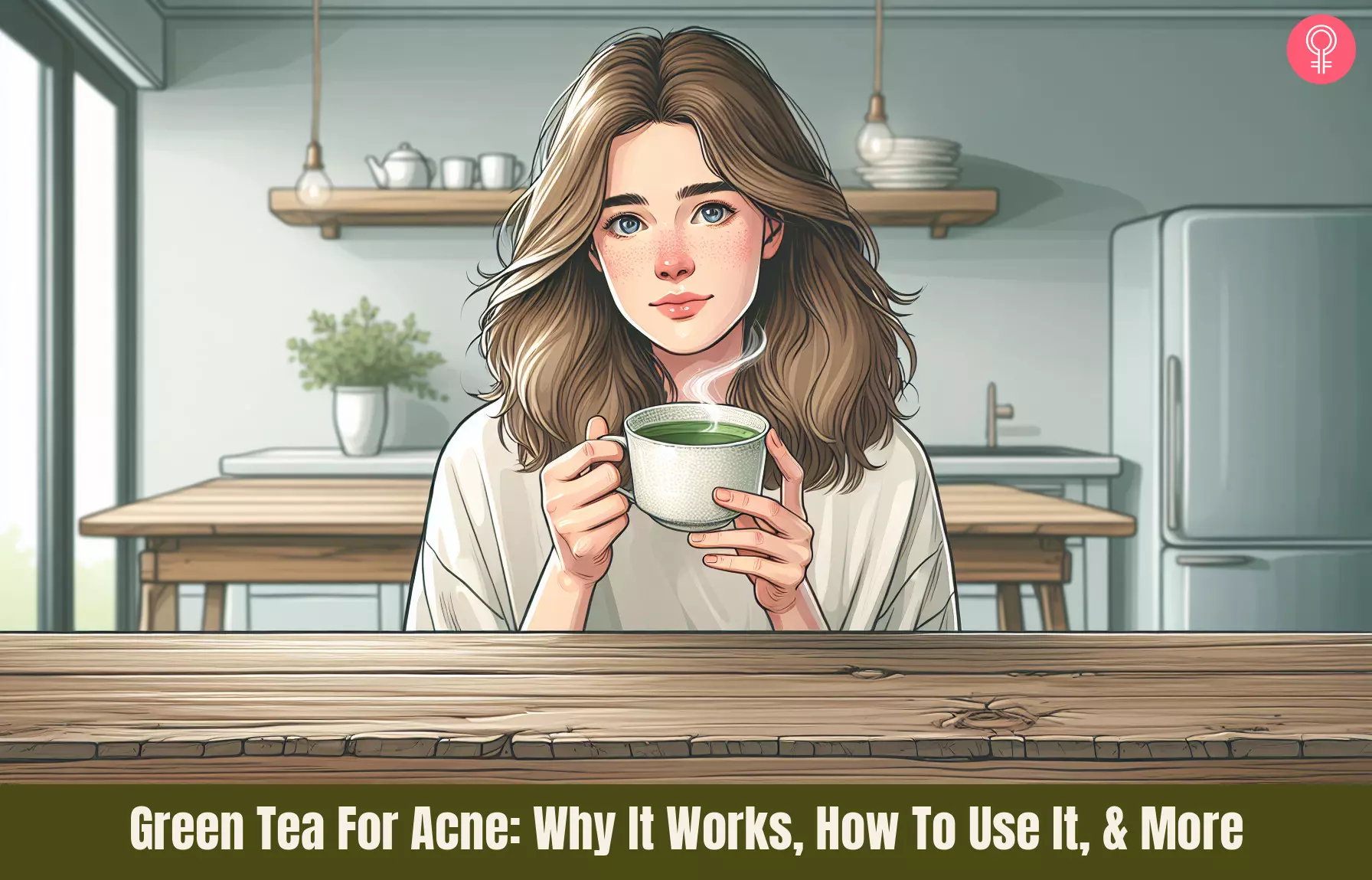
Image: Dall·E/StyleCraze Design Team
You can now get rid of your stubborn acne with a green tea detox/cleanse! Check out this video to learn how this simple drink can change your skin for the better.
Personal Experience: Source
StyleCraze's articles are interwoven with authentic personal narratives that provide depth and resonance to our content. Below are the sources of the personal accounts referenced in this article.
i. Homemade Green Tea Face Washhttps://tiffanylanehandmade.wordpress.com/2013/05/30/homemade-green-tea-face-wash/
References
Articles on StyleCraze are backed by verified information from peer-reviewed and academic research papers, reputed organizations, research institutions, and medical associations to ensure accuracy and relevance. Read our editorial policy to learn more.
- Green Tea and Other Tea Polyphenols: Effects on Sebum Production and Acne Vulgaris, Antioxidants, US National Library of Medicine, National Institutes of Health.
https://www.ncbi.nlm.nih.gov/pmc/articles/PMC5384166/ - Green tea in dermatology – myths and facts, Journal of German Society of Dermatology, Wiley Online Library.
https://onlinelibrary.wiley.com/doi/full/10.1111/ddg.12737 - Epigallocatechin-3-Gallate Improves Acne in Humans by Modulating Intracellular Molecular Targets and Inhibiting P. acnes, Journal of Investigative Dermatology, ScienceDirect.
https://www.sciencedirect.com/science/article/pii/S0022202X1536111X - Protective Mechanisms of Green Tea Polyphenols in Skin
https://www.ncbi.nlm.nih.gov/pmc/articles/PMC3390139/ - Topical application of green and white tea extracts provides protection from solar-simulated ultraviolet light in human skin
https://pubmed.ncbi.nlm.nih.gov/19492999/ - Green Tea Catechin Association with Ultraviolet Radiation-Induced Erythema: A Systematic Review and Meta-Analysis
https://www.ncbi.nlm.nih.gov/pmc/articles/PMC8233826/ - Honey: A Therapeutic Agent for Disorders of the Skin, Central Asian Journal of Global Health, US National Library of Medicine, National Institutes of Health.
https://www.ncbi.nlm.nih.gov/pmc/articles/PMC5661189/ - The efficacy of 5% topical tea tree oil gel in mild to moderate acne vulgaris: a randomized, double-blind placebo-controlled study., Indian Journal of Dermatology, Venereology, and Leprology, US National Library of Medicine, National Institutes of Health.
https://www.ncbi.nlm.nih.gov/pubmed/17314442 - Aloe Vera: A Short Review, Indian Journal of Dermatology, US National Library of Medicine, National Institutes of Health.
https://www.ncbi.nlm.nih.gov/pmc/articles/PMC2763764/ - Are Natural Ingredients Effective in the Management of Hyperpigmentation? A Systematic Review
https://www.ncbi.nlm.nih.gov/pmc/articles/PMC5843359/#:~:text=According%20to%20the%20abstract%20of,clinical%20efficacy%20in%20treating%20melasma.&text=In%20the%20study%2C%2060%20women,using%20dermatologic%20and%20photographic%20methods.
Read full bio of Dr. K. Harish Kumar
Read full bio of Eshna Das
Read full bio of Krati Darak







